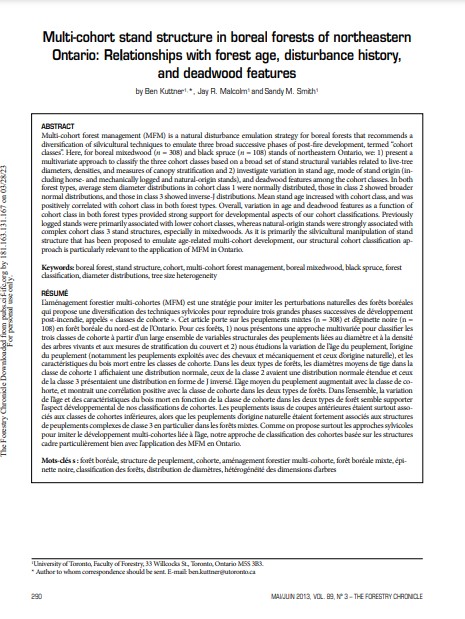Multi-cohort stand structure in boreal forests of northeastern Ontario: Relationships with forest age, disturbance history, and deadwood features
Bosque Modelo:
Lake Abitibi
Temática:
Gestión forestal
Tipo de documento:
Artículo científico
Resumen
Multi-cohort forest management (MFM) is a natural disturbance emulation strategy for boreal forests that recommends a diversification of silvicultural techniques to emulate three broad successive phases of post-fire development, termed “cohort classes”. Here, for boreal mixedwood (n = 308) and black spruce (n = 108) stands of northeastern Ontario, we: 1) present a multivariate approach to classify the three cohort classes based on a broad set of stand structural variables related to live-tree diameters, densities, and measures of canopy stratification and 2) investigate variation in stand age, mode of stand origin (including horse- and mechanically logged and natural-origin stands), and deadwood features among the cohort classes. In both forest types, average stem diameter distributions in cohort class 1 were normally distributed, those in class 2 showed broader normal distributions, and those in class 3 showed inverse-J distributions. Mean stand age increased with cohort class, and was positively correlated with cohort class in both forest types. Overall, variation in age and deadwood features as a function of cohort class in both forest types provided strong support for developmental aspects of our cohort classifications. Previously logged stands were primarily associated with lower cohort classes, whereas natural-origin stands were strongly associated with complex cohort class 3 stand structures, especially in mixedwoods. As it is primarily the silvicultural manipulation of stand structure that has been proposed to emulate age-related multi-cohort development, our structural cohort classification approach is particularly relevant to the application of MFM in Ontario.
Información Bibliográfica
Autor:
Kuttner, Ben; Malcolm, Jay R.; Smith, Sandy M.
Revista:
Forestry Chronicle
Año:
2013
N°:
3
País :
Canadá
Páginas:
290 - 303
Volumen:
89
Idioma:
Ingles
Palabras claves
boreal forest, stand structure, cohort, multi-cohort forest management, boreal mixedwood, black spruce, forest classification, diameter distributions, tree size heterogeneity





